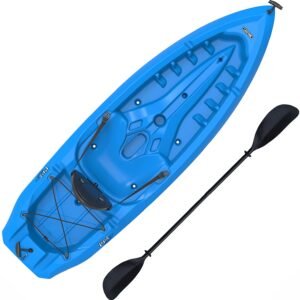You’ve got yourself a kayak with a paddle and are ready to go on to your first paddling journey. However, before you actually go kayaking, there is one important question that needs an answer: what to wear when kayaking?
Choosing what to wear on your kayaking trip isn’t merely a matter of personal taste and stylishness. If you have an accident in water, the outcomes could range from you getting a mild hypothermia to drowning due to incapacitation from cold.
All that could happen just because you aren’t dressed appropriately for kayaking. So needless to say, wearing the right gear on you is exceptionally important when on the water.
What exactly you should be wearing will depend on various factors. This is what we will be talking about on our today’s guide.
Importance of kayaking conditions
Before leaving the home for a kayaking trip, ask yourself the following two questions:
• What will be the air and water temperature?
• What kind of water you will be kayaking in?
Air and water temperature
While considering the air temperature is important before kayaking, the water temperature is actually a much more important factor.
A famous saying goes that you should dress for the water temperature rather than for the air temperature. Some people instead say that you should dress for submersion, but the logic is the same.
The risk of capsizing is ever-present when kayaking, and if you aren’t dressed appropriately for the water temperature, things could end pretty badly for you.
As we said in our material on kayaking safety tips, the human body loses its heat much, much faster in cold water than in cold air. The cold is the biggest threat to you when kayaking.
You now see the importance of being prepared for cold water temperatures, right? Fortunately, finding out the water temperature in the US is quite easy.
For coastal waters, you could pay a visit to the National Oceanic and Atmospheric Administration’s map of water temperatures. For inland water bodies, consult the USGS water data map.
Besides, don’t forget to check out the weather forecast for the area you will be paddling in. It is less important than water temperature, but it still is a factor you should be considering.
Water type
Knowing what kind of water you will be kayaking in is also highly important.
Ocean and lake waters are usually colder than river water, even more so in cold seasons. Thereby, you would need to dress more warmly for ocean or lake waters than for calm rivers.
Whitewater rapids are also almost always cold, so you should be prepared accordingly regardless of the air temperature and weather. You will most likely get wet in whitewater. And besides, the risk of capsizing is much higher in rapid currents.
And even if you will be kayaking in a shallow bay or a calm river, don’t neglect the importance of being dressed appropriately, especially if it is cold.
What to wear when kayaking in cold conditions?
You will need to take extra precautions when kayaking in cool conditions. If you do something wrong, cold water will pose great risks to your safety and health.
Wetsuits and drysuits
If the combined water and air temperature is below 120 degrees Fahrenheit, the American Canoe Association recommends wearing a wetsuit or a drysuit. Besides, you should wear one or the other if the water temperature is 60 or fewer degrees Fahrenheit.
Wearing a wetsuit or a drysuit is the staple of staying warm in cool conditions.
A wetsuit allows a small amount of water to reach your skin, which creates an insulation layer that keeps you warm. A drysuit prevents any water from reaching your skin and keeps you completely dry.
Generally, drysuits are worn in extremely cold conditions. However, they are thicker than wetsuits and thereby more restrictive on your movements. On the other hand, the much more flexible wetsuit is suitable for not so cold conditions.
So if you find that the waters you will paddling in are colder than 60 degrees Fahrenheit (or if the combined air and water temp is below 120 degrees), make sure to wear a wetsuit or a drysuit.
Cap
You should definitely wear a warm hat when kayaking in cool conditions. Most of the heat leaves the body through the head, so you should prevent it as much as possible.
Socks
Don’t also forget to put on a pair of warm socks. The good old wool socks maintain warmth quite well, but they dry slowly. Neoprene socks would be a much better idea for kayaking since they dry quickly. Some types are also waterproof.
Gloves
You should also pick neoprene gloves to keep your hands dry, on one hand, and to help you maintain your grip on the paddle on the other. In summer, you could go for moisture-wicking polypropylene gloves to keep your hands dry.
Layering
Dressing in layers allows you to easily remove or add clothes on the go in accordance with temperature changes. You don’t necessarily need to add layers of clothes on top of your wetsuit/drysuit, but it sometimes is necessary.
With a full wetsuit that has long sleeves and legs, you don’t really need to add additional thermal layers on top. A wetsuit is windproof and watertight, so it should be able to protect you from cold. For colder conditions, you could opt for a thicker wetsuit.
If your wetsuit is short-sleeved, however, you would need to cover the exposed areas of your body. A good option would be to wear quick-dry clothing underneath the wetsuit. For cooler conditions, you could put on a rain or fleece jacket or wear a thicker quick-dry layer.
With a drysuit, things are a bit different. You would need to, first of all, wear a moisture-wicking layer of clothing underneath the drysuit: this would help you avoid the buildup of sweat under the suit.
Just like it is with wetsuits, you don’t necessarily need to put on additional layers on top of the wetsuit. You can always add additional layers of clothing though if you think that they are necessary.
What to wear when kayaking in warm conditions?
You don’t have to deal with cold water in warm conditions, but you do have to protect yourself from the sun. The negative effects from the sun may not be as abrupt as with cold water, but you still don’t want to get a heat stroke or a UV overdose.
Long clothes
While you may be tempted to put on something very light on a warm day, you should go for a long-sleeved breathable shirt. During long kayaking trips, a long-sleeved shirt would protect your arms from UV overexposure.
The same goes for your pants: it would be preferable if you put on light and long pants.
Cap
You would also need to protect your head from the sunrays, especially if you are bald. It is quite easy to get a heatstroke if your head isn’t protected, so you definitely should have a cap or a wide-brimmed hat on your head while paddling.
Sunglasses
Having sunglasses on will not only help you see butter under the sunlight but will also protect your eyes. Even if there is no direct sunlight, the water could throw some glare into your eyes. If you need to maintain visibility while kayaking, go for polarized sunglasses.
Sunscreen
If you will be covering your skin under a long-sleeved shirt, long pants, and a hat, then you may not need to apply a sunscreen. However, if any part of your body will be staying out in the open under the sun, then you should definitely apply sunscreen to those areas.
You should probably apply sunscreen anyway regardless of whether all your body parts are covered or not. You still could get burns from the sunlight reflected from the water surface.
Even if the day seems cloudy, don’t neglect the sunscreen completely. If you won’t be applying it, at least take it with you in your dry bag so you can apply it if the sun decides to show up.
What to wear when kayaking in any conditions?
Waterproof footwear
Wearing waterproof footwear is a must in either cold and warm conditions. Neoprene booties would be a perfect choice because they are lightweight and protective. However, any footwear that can protect you from water would be a good option to wear.
You may want to avoid sandals, flip flops, and basically anything that doesn’t have a back strap. You could just lose them while kayaking.
If you happen to be looking for kayaking shoes, then check out our roundup of the best water shoes for kayaking.
Quick-drying fabrics
Wearing quick-drying fabrics is a good idea. The clothes that will be touching your skin should be made of wicking and quick-drying materials like polyester. Basically, virtually any synthetic fiber would be appropriate.
Avoid cotton clothing since it easily absorbs water and stays wet for a long time. Wool would be a better choice: it dries not as quickly as synthetic fabrics, but it will insulate you from the cold when wet.
Abrasion-resistant fabrics
You’d also want to consider wearing clothes made of durable fabrics that could resist tear and wear well.
Additional tips on clothing
Take spare clothing with you
Regardless of how well-dressed you are for the kayaking trip, make sure to have a spare set of clothing with you. Put the spare items in a dry bag so they don’t get wet in case of an accident.
There is one thing to keep in mind: don’t be lazy to put all the necessary clothing on you before the actual paddling. Don’t you think that you could, for example, put the wetsuit on after capsizing: the cold water would have already done its job.
Wear your PFD at all times
We have already said this in our kayaking safety tips material, and we should say it again. Never take your personal flotation device off when kayaking.
You can’t say when and what things could go wrong. It’s the same as with clothing: once you get in an accident, it will be too late. However, you could just plain drown if not wearing a life jacket.
Put a spray skirt on your kayak
If you have a sit-in kayak, then putting a spray jacket on the cockpit would allow you to protect your body from water splashes.
But don’t think that a spray jacket will replace you a wetsuit and warm clothing: you should use both. If you capsize, the spray skirt won’t do much for you.
We have a spray skirt buying guide, by the way, so check that out as well.


